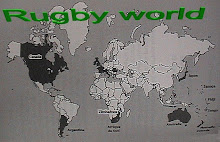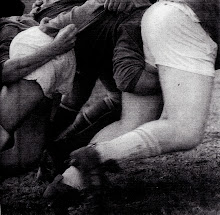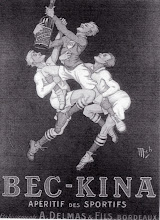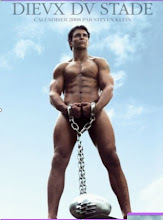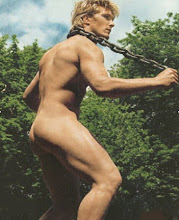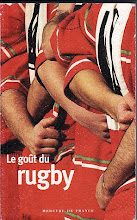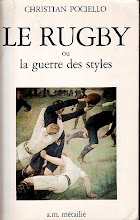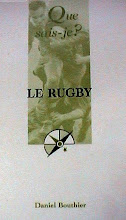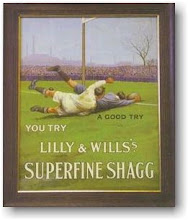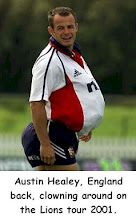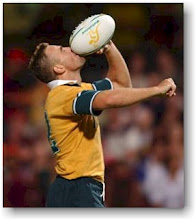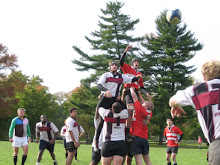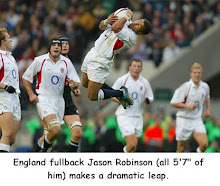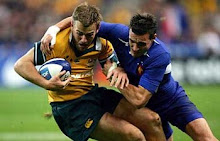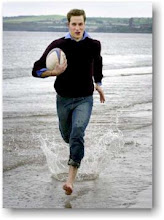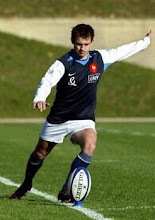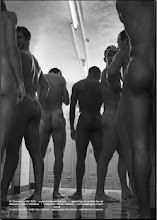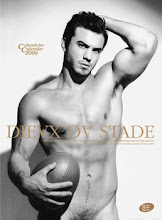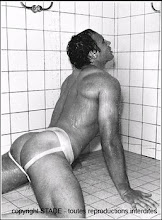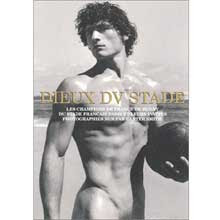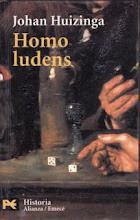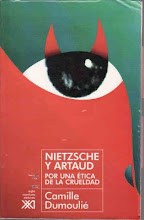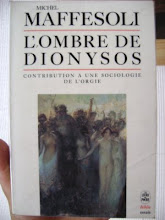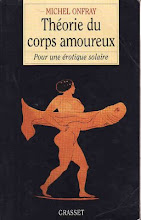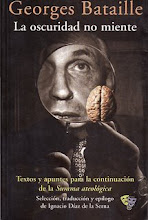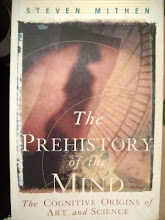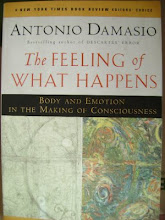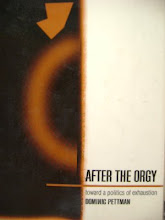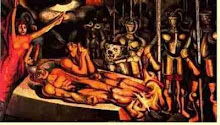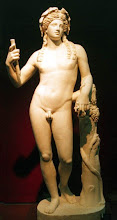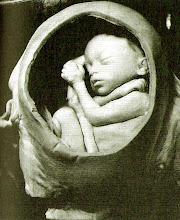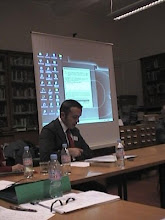Dear visitor, due to a technical problem with the You Tube video bar, please "actualize" this page many times as necessary until Rugby videos display correctly (Rugby's green screens upper right side). Different videos could be seen as many times the icon "to actualize" located at the Internet bar next to "Favorites" is pressed. Please retry as many times as necessary to watch a explanatory simulation of Rugby's game. Enjoy them and any comment on this blog will be wellcome!
Thursday 3 April 2008
Some writers have described the importance of the Rugby's third half-time “troisième mi-temps” , there where the TV cameras arrive to transform intimacy in spectacle. We all know that half time means “to take a break” in every culture and in every kind of activity. Humans need to make pauses in almost all their activities. Sleep, for example, has been suggested by neurologists to be indispensable not only to renewing physical forces but also for the reconfiguration of our brain that makes a selection to save some memories and others not of the lived day. The same hypothesis has been applied to many phenomena as sportive games, religious trance or rave parties, where people live healing experiences. In this sense, holidays also represent an annual secular-sacred pause where sedentary life (work, family and general abstinence) is substituted by solar, economical, sexual, briefly, ludic activity excesses.
Whoever has participated in a team activity knows that half-times normally consists in a pause where coaches and players take a breath, drink water, talk and motivates each other, planning their next strategies. In theater or cinema production f or example, I have testified how actors get their concentration recovered by a drink accompanied wtih anphetamines alcaloids.
Suggested lecture
Raymond Abellio, « Géographie sacré du Rugby », Dans un âme et un corps, Gallimard, 1973. (Writer and Rugbyman)
Suggest Video
Sandbach Rugby Team, Generation Xcess, ITV2
URL: http://french-rugby-players.com/
Ritual Practice in Rugby.
One day, as Jean Prévost was having a drink at a PUB in New Zealand, he met an unknown man talking to him about the dream of many people in this country to become an “All Black”, that is to say, a national Rugbyman. Then they talked about the “Haka”, maori’s war song that this team uses to sing before every match. To see an example of this rite, please refer to the video bar above this blog.
Suggested lecture
Jean Prévost, « Avant la bataille », Plaisirs des sports, essais sur le corps humain, Gallimard, 1925. (Writer and Rugbyman)
Ludus pro Patria
« Rugby is a summary of the human adventure, a theater, a psychodrama of human behavior, from the most archaic to the most complex, from the most detestable to the noblest, from the most impulsive to the most rational.... The wardrobe/dressing room/vestiaire becomes the cave of the mutations.... It is a silent chapel where the walls shine with the vestments’ decorations that are the uniforms. ... It is the sacred place of ritual behavior inherited from the night of the ages ».
Suggested lecture
Daniel Herrero. « Un raccourci de l’aventure humaine ». Dictionnaire amoureux du Rugby. Plon, 2006. (Rugbyman, French Champion, 1987)
Solidarity in Rugby
« Rugby team consists of fifteen players, eight strong and active, two light and resourceful, four huge and fast, and the last one, model of phlegm and cold blood. This is also the ideal proportion in human groups ».
Suggested lecture
Jean Giraudoux. « Recreation virile ». Le sport, notes et maximes. Hachette, 1928. (Writer)
Commercial desacralisation in Rugby
« I consecrated all my life to Rugby that has its true roots in London... at 70 years of age Rugby remains in my life, in my heart, after my family. I continue with passion, but my passion is threatened by the evolution of the game. The brutal step to the professionalisation has changed everything. And I cannot believe it that has been produced by the own Englishmen that defended the amateurisme for a whole century. Rugby in France is still a sport of small cities like Mont-of-Marsan. I fear that its fundamental values as friendship, solidarity and team spirit might disappear. »
Suggested lecture
André Boniface, « Un Landais britannique », Nous étions si heureux, La Table Ronde, 2006.
Rugby as religion
Many people, fanatics and players ask to be buried with their official sportive equipment. This fact links Rugby game with the most profound of sacred human rituals, burials and homage to the dead.
Suggested lecture
Pierre Sansot, « Magie, pratiques incantatoires et croyances obscures », Le rugby est une fête, le tennis non plus. Payot et Rivages, 2005. (Anthropologist)
Identity in Rugby
« Rugby is a continent of emotions and references, an expressive song and thousands of songs to drink, a people that reencounters its own language wherever, Auckland or Narbonne, Cardiff or Brive. »
Suggested lecture
Marie Darrieussecq. « Un fantôme dans les tribunes ». L’Équipe Magazine. Samedi, 29 juillet, 2006. (Writer)
Bodily ethics in Rugby
No other game than Rugby in Western culture permits such bodily contact within the team. Corporal proximity and non aggressive touch becomes a main principle of the game. This practice evidences another form of tactile ethics, making disappear for a moment the canonical tabues of our culture in regards to corporal frontiers respect.
Suggested lecture
Anne Saouter. « Contact ». Être Rugby, jeux du masculin et du féminin. Maison des Sciences de l’Homme, Ministère de la Culture et de la Communication, coll. Éthnologie de la France. (Anthropologist)
Excitement and Cardiovascular Events during Rugby match watching
Bordeaux, 1965. semi-final Ang-Dax, three deads caused by cardiovascular events. The emotion... In Rugby spectacle as in Greek theater, there is no distance between players and spectators. The group sings and cries, exists…
The International Federation Football Association (FIFA) World Cup, held in Germany from June 9 to July 9, 2006, provided an opportunity for scientists to examine the relation between emotional stress and the incidence of cardiovascular events. The conclusion supports that viewing a stressful soccer match more than doubles the risk of an acute cardiovascular event, particularly in men with known coronary heart disease.
Suggested lectures
Michel Serres. « Le choeur antique sur le terrain. Le culte du ballon ovale ». Le Monde, 4 mars. 1979. (Philosopher)
Ute Wilbert-Lampen, et. al. Cardiovascular Events during World Cup Soccer. The New England Journal of Medicine. Boston, January 31, 2008. Vol. 358, Iss. 5, p. 475-83. URL: http://proquest.umi.com/pqdweb?did=1421641381
Team’s Solidarity efficacy narratives and ritual cohesion in Rugby
«There are not Rugby players, only Rugby teams ». Cult of the impersonality and of the distribution of tasks. The small ones infiltrate, the big ones advance, the agile ones escape. The athletes of Rugby form a solidary team nearer to the daily life tasks.
The relationship between perceived cohesion and collective efficacy in rugby teams has been studied by exploratory scientific studies. Self efficacy represents the degree to which one believes that one can successfully execute the behavior required to produce a specific outcome. These efficacy beliefs are thought to have important motivational implications in that they impact an individual's choice of activity, effort, and persistence. Self efficacy is hypothesized to positively influence performance. High levels of self-efficacy enhance performance and reduce the negative effects of defeat. Efficacy beliefs differentiate between successful and less successful athletes in situations of competitive stress. Collective efficacy could be indeed an extension of self-efficacy. Collective efficacy beliefs are hypothesized to have substantial implications for group effort, persistence, and performance, especially for tasks requiring interaction among group members. A strong sense of collective efficacy allows great teams to come from behind to win even when they are not playing their best. On the other hand, mediocre and inconsistent teams are often plagued by lower levels of efficacy and a degree of self doubt.
Suggested lectures
Antoine Blondin, « Le jeu d’une société plus qu’un jeu de société », Mes Petits Papiers. Chroniques et autres essais littéraires, La Table Ronde, 2006 .
Stephen A Kozub, Justine F McDonnell. Exploring the relationship between cohesion and collective efficacy in rugby teams. Journal of Sport Behavior. University of South Alabama, Jun 2000. Vol. 23, Iss. 2, p. 120-129 (10 pp.)
Visual Training in Rugby
Most team sports spend a considerable amount of time devoted to the physical and skill development of players. Fundamental to this process is the involvement of the visual system, and yet rarely do we hear of this quality being catered for within the strength and conditioning program.
Because this ability to focus is so limited, peripheral vision becomes increasingly important in sports. Our peripheral vision is designed to quickly detect motion so that the visual focus can be directed to other events. Size of an athlete's functional visual field is not fixed but varies according to a range of factors (e.g., the concurrent demands of activities performed in central vision; level of stress, fatigue, arousal). As a simple rule, the more complex and demanding the centrally performed task, or the more stressed the athlete, the narrower will be the functional visual field size, resulting in errors that coaches often describe as tunnel vision.
It has been said that we live in a Vision Culture. Nevertheless, the reality demonstrates that we do not know at all how to see. Even though our visual capacities for quick movements have been developed during the second half of the XX century by media technologies and videogames, I could say that we have lost our capacity to look carefully. Try yourself an experiment as you are in a museum or wherever. How long can you really “observe” the details in paintings and sculptures with carefully attention…, may be you will stand in front them longer than usually and you will not pass away quickly…but your mind will be "ailleurs"... I thought I used to see "properly" art works as a neurologist demostrated I was wrong and I am training to reeducate my visual habits. Coming from a more contemplative culture than Europeans, I think it is possible to do it. Mexicans in that sense are closer to Eastern cultures… as one travels through the country, one perceives this ethnical capacity for contemplation that surely has been a heritage from the most ancient immigrants coming from East that arrived to our country a long time ago… this is what I love to explain to foreign people who laughs about that traditional image of a Mexican sitting with his hat next to a cactus plant for hours and hours…. Visual capacities let us go down the trees and construct civilizations...
Coping strategies in Rugby
First class professional male rugby union players have pointed out that the most frequently coping strategies are increased concentration, blocking, positive reappraisal, and being focused on the task, being focusing on task and increasing effort the most effective coping strategies.
Adam R Nicholls, et. al. Stressors, Coping, and Coping Effectiveness Among Professional Rugby Union Players. The Sport Psychologist. Champaign:Sep 2006. Vol. 20, Iss. 3, p. 314-329.
URL:http://proquest.umi.com/pqdweb?did=1161961681&Fmt=2&clientId=15403&RQT=309&VName=PQD
Rugby was born in the British region of this name toward 1823 during a football match when suddenly a player decided to score a goal with the hand. With this transgression of the rules would begin not only a sport where two teams would fight for an oval ball and not for a spherical one, but the team's sport in the Anglo-Saxon world par excellence. Rugby has been interpreted by the specialist as one of the most intelligent and complete of the team’s sports where body and mind conciliate the principal Western duality. Rugby also has been considered to have a moral quality that set it above all sports (according to its players and philosophers).
“Violence is an integral part of Rugby game”. Nevertheless, according to the Victorian tradition of the British Justice where every judiciary cases should be discussed without a written Constitution, Rugby, as it born during the Victorian period, didn’t need at first of referees and the rules were decided through discussion between the captains of the two teams until 1885. This sportive practice was supposed to be a perfect application of the British gentlemanly ethics.
With their emblematic colors and their mythical stadiums, Rugby teams are worldwide recognized by their symbols: Rooster (France), clover (Irland), leek (Gales), rose (England), thistle (Scotland), fern (All Blacks of New Zealand), puma (Argentina), antelopes (Springboks); enigmatic colors as red and gold for the Dragons of Perpignan… Looking through the Rugby of five Nations, I wonder why this game has been developed in so different countries… may be a kind of protestant evangelization. Rugby is known as the king of the sports, indispensable place of party that the church is not. In South Africa for example, Rugby has become the substitute of the war to liberate and to discipline the violence, giving an identity to a whole country.
I have checked it out some affirmations to think about the great musement that Rugby could means for players, coaches, writers, philosophers and journalists. This selection is a result of a heterological point of view about knowledge and opinions on Rugby. I have refered above those ones that have captured my attention as they talk about Rugby not only as a successful media sport phenomena, but as a ritual practice full of significances: as a way of being, as a secular religious substitute for many people involved with its incantatory practice: players and spectators...
I refer also in this blog some data on human evolution that fascinated Bataille and helped him to understand phenomena such Art, Eroticism, Religion and Play. Consecuently I refer an own perspective in what the notion of Musement used by Charles Pierce could signify in the context of heterological studies related to a French tradition of “thinking the Excess”, viewed through an american gaze of an Erasmus Mundus student, me or we (multiple voices in me), as you prefer…
Excess, ritual activity and evil’s homeopathisation
This kind of ritual domestication of the violence present in Rugby is just what the sociologist Michel Maffesoli after Nietzsche, Bataille, Mauss and Durkheim calls poetically an “Evil’s homeopathization”. As everyone knows, this type of traditional medicine functions under the principle that a little controlled quantity of the same substance/poison that provokes an illness (the same principle works in allergology treatments as I have tried) permits sickness self-healing. In that sense, Georges Bataille understood metaphorically excessive and heterological processes in societies as collective healing procedures.
These bataillean ideas on Heterology began to be known by a very little contribution of the author to a volume of the Cahiers de la république des letters, des sciences et des arts (1928). His article was entitled “Extinct America” and was published for the commemoration of the first major European exhibition of pre-Colombian artefacts. Bataille knew just a little about those cultures, but a friend of him called Alfred Métraux, specialist in the ethnography of Latin America suggested him some books, principally, The History of the Conquest of Mexico, The History of the Conquest of Peru and the famous Bernardino de Sahagún’s General History of the Things of New Spain. With these few books Bataille began his amazing work.
Reality demonstrates that humans, biologically, psychologically and socially, share an innate necessity of healing rituals and narratives to accompany them. Nowadays there are many studies that suggest that a strong religious faith could prolong life and also heal many diseases. How does bodies are penetrated by symbols???
Aztec mass-sacrificial practices demonstrate the possibilities of such strong religious faith. By sacrifying hundreds of prisoners they believed that solar deities could be feed with blood and indeed, human life could be perpetuated. Through their astronomical estimations, they thought that they were living the last solar cycle and after it, world’s destruction would arrive. Specialist today argues that based on their estimations, solar death would arrive in this decade, but in reality nobody knows profoundly about these mathematical calculs as this testamentary knowledge was almost completely destroyed by Spaniards. Bataille, coming from a classical-cartesian culture such as France, was fascinated by these belief
I can not imagine any warrior (Aztec or rugbyman) that does not have a profound sense of Sacrality, as in every combat, real or simulated, there is always a obscure belief related to a supernatural force that determinates the victory or the defeat. At first, Aztecs were a nomadic people that travelled hundreds of kilometers from a mythical place in North Mexico called Aztlán until they found the symbol that once an oracle has signaled to be the best place to construct the center of their empire: an eagle would be standing on a cactus eating a snake. Imagine the force and the religious faith they should have in their gods to keep such travel full of combats, hunger, sickness, death. I suggest that Catholicism has profited from this profound religious sense of the Mexican people to establish since those days an almost totalitarian cult. Of course they had to adapt many aspects of that religion to some of the inner native religious senses of Mexican peoples (as Aztecs were only one of the fifty-two ethnical groups that remains on Mexican territory); polytheism has been adapted under canonization of multiple saints, for example. As one travel into Mexico, it is advertised the inexistence of a total cultural hegemony and that a Mexican Nation is in a real sense, a myth constructed by intellectuals and politicians during the XIX century.
This heterological image of an eagle standing on a cactus and eating a snake has been the national symbol for centuries and probably the one that Bataille studied at first as he worked with medals and monies no longer in circulation at the National Library (this study is known as numinastics and the author worked on it around 1926). Today the sacred place that this symbol would indicated once for the Mexicans is almost completely destroyed under and next a monstrous construction of a baroque cathedral constructed under Spanish catholic orders. A little beat of golden exuberance can be appreciated there nowadays; Aztec gods and goddesses were transformed into catholic decorations. Once there was the great Temple of the great Tenochtitlan, city of Huitzilopochtli, other son of the Sun. There was also a Great Mother’s worship, of Coatlicue, related to the underground forces as well as to growing corn. But there is another deity, probably the most heterological one called Tezcatlipoca, “fuming mirror” who represent the Otherness, the unknown Sun’s son whose stories remains obscure. Almost none talks about him nowadays...
As an Erasmus Mundus student enrolled in a Master specialized on Heterology and obligated to come back to my country just after finishing my 1rst. Semester at the University of Perpignan because of official procedures in order to get a students visa from the Portuguese Embassy in Mexico, staying at home and having to write a paper on Rugby, I realized that, even though I got many books on Rugby, watched many matches of the last World Cup in France, I could not assimilate Rugby’s Musement. Probably because I did not know the rules of the game or/and I do not have any affective link with it as in my culture is totally unknown. Nevertheless, through reading Bataille’s works such La part maudite or Les larmes d’Eros; and reading again the Popol Vuh, the maya-quiché bible during my several half-times of more than a hour in the Subway between the Portuguese Embassy (North of Mexico City), the city’s downtown where lay almost every government’s offices and my house (South of Mexico City); and taking a look at popular daily life of one of the biggest cities of the world, I realized that Rugby is not so far from the secular religious excitement that football provokes in my country. Football teams like “America” property of Televisa, one of the biggest television chains of Latin America, or Pumas, the University’s team, or Chivas, from the beautiful city of Guadalajara, are also worshipped next to the Virgin of Guadalupe or Jesus Christ. As my close family is composed only by women who do not enjoy watching “classical” football match on Sunday, personally, I do not feel any kind of empathy with this sport as with Rugby (I only enjoy World Cups and I think it has to do with a very personal visual Musement that comes from watching how national teams win or loss), but I realized how important could be for others and also “sacred time” , for example my uncle who has worked for thirty years in a football’s newspaper only because he loves Football, his daughter is called America because it is the name of his preferred team... that newspaper curiously is the one with the biggest number of daily copies in circulation in Mexico City. Football is a public affair, more important for the public opinion than politics. Faith in Christianity redemption is shared many times with faith in footballs players one.
All this to say that, even though I could not assimilate Rugby’s sense, precisely not assimilating is one of the purposes of heterological perspectives. Otherness should remain as Radical Alterity, even if we try to think about it, always its final sense should escapes from our hegemonic thought. If not, then we are not walking on a heterological field. Rejection or fascination are the main reactions to heterological processes. Bataille has proposed us with his work to explore the roads of rational thought, forcing it extremely to its limits. He remembered us the response of one of the greatest philosophers of Western culture, Georg Wilhelm Friedrich Hegel, to his own rationalist consciousness; as he was realizing a heterological consciousness escaping from his system, he confessed to a friend by a letter that if he would continue he surely would drive mad, so, Hölderlin’s friend decided to close his system and dedicate his days to repeat his courses and to play cards... Go farer is dangerous for mental sake. Maybe Hölderlin, Nerval or Nietzsche took the risk of the heterological vision with a costly payment. Nobody can sinks completely into Heterology, madness or death are its closest manifestations as we can realized, but the problem remains that in these two cases, there is no return to consciousness’ life and the baitallean way is finally an invitation to think, no to drive mad or die, even if his invitation consists in thinking in a different way, a kind of a slowly brain’s gymnastic training running through the possibility and the impossibility, the rational and the irrational, the cultural heritage and the biological principles, briefly, through the crossroads of human activity and inactivity: from sexual reproduction, eroticism and sacrifice to meditation, inner experiences (related to Musement), literary writing, passing by economics, politics, anthropological data, aesthetics, etc.
- Georges Bataille, La part maudite. Essai d'économie générale, Les Éditions de Minuit, 1949. Tr. Francisco Muñoz de Escalona).
- René Girard, La violence et le sacré, Paris, Hachette, 1970.
- Michel Maffesoli, La part du diable. Précis de subversion postmoderne, Paris, Flammarion, 2002.
- Vincent, Jean-Didier, La chair et le diable, Paris, Odile Jacob, Sciences, 1996.
-Tony Collins. “Violence, Gameship and the Amateur Ideal in Victorian Middle-Class Rugby” in -Mike Huggins (ed). Disreputable Pleasures. Less Virtuos Victorians at Play. London, Frank Cass, 2004. Ch. 8.

Bataillean Heterological Approach to the Anthropological View of Play’s function in Human Evolution
Six million years ago humans shared a common ancestor with chimpanzees. Chronically after that many hominids appeared as australopithecus ramidus 4.5 million years ago; homo habilis 2 million years ago with first stone tools and a increase in meat consumption; homo erectus 1.8 million years ago as African emigrants; homo neanderthalensis as survivors in Europe until 30,000 years ago, and finally, homo sapiens sapiens 100,000 years ago with the emergency of the human modern mind during the cultural explosion 60,000-30,000 years ago.

Suggested lectures
Bataille, Georges. “La volonté de l’impossible.” Dans Oeuvres complètes. Paris, Gallimard, NRF, p. 19. T. XI.
Taylor, Timothy. The Prehistory of Sex. Four Million Years of Human Sexual Culture. New York, Bantam Books, 1997. p. 3.
Bataille, Georges. Lascaux ou la naissance de l’art. Genève (Suisse), Éditions d’Art Albert Skira, 1955:
Michael Chapman’s film, The Clan of the Cave Bear (1983) reconstructes the encounter between Neanderthals and Sapiens based on Jean M. Auel’s novel.
Mithen, Steven. The Prehistory of the Mind. The Cognitive Origins of Art and Science. New York, Thames and Hudson, 1996. Evolutionay psychology has been also developed mainly at UCLA (Santa Bárbara) and particularly at St. Andrews’ University.

Key book to access Bataille's thinking. Interesting as it explains the phenomenology of Eros. That is to say, life needs death to be, cells divide themselves to keep life alive. Sexual reproduction functions in a similar way. Orgasmic little death is seen by Bataille as a simulacrum of the great dead. Boundlessness, great pleasure instant of conciousness lost. Mysticism as well has something to do with great Eros focused on God. Budism is closer of a mystical atheism in daily life. No trascendental gods, only heroes of Musement as film actors, politicians, Rugbymen, etc.
Irreality of Rugby’s Reality. A Testimony.
 When I was 10 years old I made my first representative sporting team. I was called out after a tournament and stood in front of a crowd with my fellow team-mates. Everybody clapped us and I felt on top of the world.
When I was 10 years old I made my first representative sporting team. I was called out after a tournament and stood in front of a crowd with my fellow team-mates. Everybody clapped us and I felt on top of the world. Everyone in the team was given a shirt. Sometimes when I wore mine down the main street I saw people look twice. Sometimes they whispered or nudged and pointed - maybe they'd recognised me, because I was in the local paper too.
Even when you're young it doesn't take you long to realise that, right or wrong, the shirt and the article - the sport - make you special to people. That sense comes especially quickly when it is something that you're continually told. I kept making representative teams through the years and the coaches of them constantly reminded me of how talented I was. It was something repeatedly reinforced to me as I grew and something that, as a teenager, I easily accepted, as any would. The adulation of adults was only exaggerated when I was on the pitch and people were screaming for us.When you graduate from the junior grades and enter the top flight it's obvious that adoration takes a significant step up again.
“But at the time I didn't have that perspective. As a "sportsperson" from a young age, I grew up in a sort of cultural vacuum. In so many ways I was separated from the rest of society and lived in a world where only myself and my team-mates trod.”
Also, it just didn't seem so stupid. When I was out people used to come up to me and my team-mates, often just to wish us well, and that made me feel even more exceptional. Plenty of them were women and some weren't so subtle about the fact they wanted to have sex with me.
Sometimes I would go up to a girl and get rejected. My reaction was often one of bewilderment. Why doesn't she adore me, if everyone else apparently does? The women I did sleep with sometimes didn't seem to care if it was me or any other member of my team. I felt it wasn't the actual person they wanted but just to sleep with a sportsperson.
As part of a team sport I felt like individuality was not needed or even wanted - everything we did, we did as a team. We sweated together at training and on the field we were told to sacrifice ourselves for our team-mates. "Don't let the man next to you down" was our unofficial motto.
If I made a mistake I wasn't angry with myself, I was upset at letting my team-mates down. I gained satisfaction not from my individual achievements but from my team-mates seeing what I would do for them.
I think that when you wake, walk and talk team ethic all day, every day, this is why sportspeople sometimes engage in group sex. There are plenty of women who choose to engage in it too - and enjoy it. Sportspeople are taught to conduct themselves as a group. Sometimes that team ethic extends to sex. And I don't see any issue with that - so long as all those involved consent to it at all stages.
I believe the trouble with some sportsmen can be that they are not conditioned to accept rejection or refusal. The process of being convinced that you are special often begins before you are even a teenager. The rules that apply to everyone else don't seem to apply to you.
Those who are too young or simply too immature to realise the psychological cocoon they inhabit as a sportsperson is an unreality may hear the word "no" but they do not accept it. The consequences of that can be horrendous…
1. David Elton. Football: 'I lived in a world where only me and my team-mates trod': A former rugby league player on the psychology of sex and stardom . The Guardian. London (UK):Mar 6, 2004. p. 2
Wednesday 2 April 2008
 Many thinkers talk about Rugby as a reappropiation of feminity by men, a lost value in Western history, but feminity in ancient cultures was worshipped related to ground's and women's fertility. Ovaline's archetype may represents a return of Great Mother's values by the representants of the sword's masculinity and vertical power in such a society that has invented the modern Commonwealth. Researchers from sociology to biology argue that nowadays we are living in a world where feminity is increasing. Sperma concentration for example, is permanently decreasing and more girls are borning than boys. Last week Yahoo's principal New take about a pregnant man as Zeus in mithology was giving birth to Dionysos or Athena. Evidently there are today more women in the world than men and in cultural phenomena such as ecologism or mode demostrates a predominance of feminity over masculinity. Paradoxically Rugby's masculinity is held by ovaline values. Metaphorically we could interpret the moment in which the Ovaline is gloriously liberate from that men's spider as a birth labour!
Many thinkers talk about Rugby as a reappropiation of feminity by men, a lost value in Western history, but feminity in ancient cultures was worshipped related to ground's and women's fertility. Ovaline's archetype may represents a return of Great Mother's values by the representants of the sword's masculinity and vertical power in such a society that has invented the modern Commonwealth. Researchers from sociology to biology argue that nowadays we are living in a world where feminity is increasing. Sperma concentration for example, is permanently decreasing and more girls are borning than boys. Last week Yahoo's principal New take about a pregnant man as Zeus in mithology was giving birth to Dionysos or Athena. Evidently there are today more women in the world than men and in cultural phenomena such as ecologism or mode demostrates a predominance of feminity over masculinity. Paradoxically Rugby's masculinity is held by ovaline values. Metaphorically we could interpret the moment in which the Ovaline is gloriously liberate from that men's spider as a birth labour!
Professor of Aesthetics at the University of Rome at Tor Vergata, Mario Perniola is a specialist in Bataille's work. One of his last studies, The sex appeal of the inorganic (2004) studies the encounter between philosophy and sexuality, between things and humanity. According to his ideas, there are living objects of desire as well as obscure objects that are inanimated... Desire and pleasure are rejected nowdays face to a neutral ascetism, inorganic and artificial. Postmodern mystical atheism. What happens exactly with the oval imaginary in Rugby? Are there things that feels? What are organs, things that feels too? What about our organs in a neuter sexuallity? Does neutral sexuality means bisexuality or multisexuality? Sensuality and eroticism played in every atmosphere instead of direct and violent sexual penetration with quickly orgasm could be a tentative option for the Westen culture, in a way as tantric coitus interruptus... that is musement. For many people it is impossible to imagine a sexuality without orgasm as a goal, vitalistic spirituality conceives the world and everyone of its elements full of living forces. To neutral sexuality we arrive by sexual abstinence... then philosophy and other practices become an inversion of sexual libido. In his chapter, "Exemplary Addictions", Perniola refers philosophy as a substitute of drugs to enter into the world of excess, not through literature or poetry or sportive games. Perniola says "it is time to see marriage and the university on the side of the evil, as pushers of sexual and philosophical excess that one cannot do without, rather than on the side of good as remedy to sexual and cognitive libido." (Kant and the Spouse as Thing". p.18). Perniola opens a strange question, what do objects feel? What about the ovaline in Rugby? I could ask. Unlike the idol which is representational, that is, the image of a divine being, the ovaline does not represent anything, its value is in itself as object. Ovaline fetichism crosses into magic, marking the triumph of an artificial object which is actually offered in its opaque and indifferent arbritariness, in its being as a sentient thing.... (p. 54-55) Remember how players kiss the ball... or in other case.. how people feels their cars as an extension of their body and any agression to them (crash) is felt as a direct agression to their person and bodies...
Tuesday 18 March 2008
 Tonal means physic world, Nagual means fluidity and transformation: ritual practice, dance, ASC's (Altered State of Counciousness), Mysticism. Heterology is closer to Nagual, and that does not mean they as Alterity are outside this world:
Tonal means physic world, Nagual means fluidity and transformation: ritual practice, dance, ASC's (Altered State of Counciousness), Mysticism. Heterology is closer to Nagual, and that does not mean they as Alterity are outside this world: Monday 25 February 2008
L'Équipe de l'Ovaline.

Rugby, mass-phenomenon of unspeakable attraction, whose primary condition evokes a pure non-utilitarian experience of collective superfluous expenditure, or, as Georges Bataille would say, of non-utilitarian dépense. Its principles and historical-cultural conditions of emergence could be explored as well as its actual development as one of the main current “European sport spectacles”. Some philosophical, anthropological and sociological works could be quoted in order to interpret its own imaginary realm as a ritual performance, as heroism and defeat in combat, as tribal cooperation and team ethics, as regional identity, as affective bonding, as homeopathy of violence, as ovalin sacrality, incantatory practice, etcetera.
Like any piece of art, contemporary social phenomena as Rugby response to particular historical contexts as well as political, economic and affective needs. Nevertheless, the innovative approach of “The Perpignan School of Heterology” proposes an inversion of the traditional critical method on Art: study first contemporary artistic and social phenomena and then see what they can tell us about art and society in previous periods and as a Gestalt.
In this direction, the work of Georges Bataille can be used as an interpretative paradigm for the mass spectacle of Rugby.
As in contemporary art where lacks internal coherence, rugby match could be interpreted as a concentric receptacle where antagonistic forces overflows the rigid rules of the “traditional and boring aesthetic, social and sportive game”.
Monday 11 February 2008
MUSEMENT by Charles Pierce.
 Enter your skiff of Musement, push off into the lake of thought, and leave the breath of heaven to swell your sail. With your eyes open, awake to what is about of within you, and open conversation with yourself; for such is all meditation."
Enter your skiff of Musement, push off into the lake of thought, and leave the breath of heaven to swell your sail. With your eyes open, awake to what is about of within you, and open conversation with yourself; for such is all meditation." 




